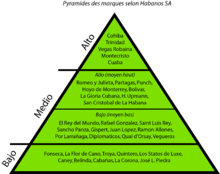Habano
Habano (male because el cigarro; in German-speaking countries as a Havana cigar or short the Havana known) is the name for one of Cuba originated and from Cuban tobacco produced cigar . Habanos SA is the exclusive distributor of these cigars . The name is derived from the city of Havana , where the main port for exporting cigars abroad was. The most famous manufactories for the production of Habanos are also located there.
The name Habano is reserved for cigars weighing at least three grams, which are produced in Cuba under defined quality criteria of the local tobacco industry and consist of black tobacco, grown in different regions of Cuba, which are also protected by their designation of origin. The more expensive Habano brands are rolled exclusively by hand, the cheaper ones are partly also by machine.
Cultivation and processing of tobacco
Growing areas
The main growing area for habano tobacco is the province of Pinar del Río , in the far west of Cuba. Rainfall, soil conditions and temperature are ideal here.
The growing area for the best tobacco is in the Vuelta Abajo region , which extends around the city of Pinar del Río , San Luis and San Juan y Martínez . However, only around a quarter of the area is suitable for growing tobacco for Havana.
Another growing area called Semi Vuelta is located around Consolación del Sur , also in the province of Pinar del Río. However, only a small percentage of the local tobacco production is used for the production of habanos.
The Partido growing area is located around San Antonio de los Baños in the Artemisa province . The area was discovered for growing tobacco in the early 17th century. Similar to Semi Vuelta , Partido specializes in the cultivation of bracts for the Habanos.
The easternmost tobacco growing region for the Habanos is called Vuelta Arriba and is divided into two areas:
- Remedios , which extends from the town of the same name in the province of Villa Clara south to the province of Sancti Spíritus to just before the city of Trinidad : the largest and oldest tobacco-growing area. The tobacco grown here has its own typical taste and is only used for a single Habano brand: the José L. Piedra .
- Oriente : Columbus landed here in 1492 and also discovered Cuban tobacco. Tobacco is still grown here today, but it is not used for the production of Habanos.
Cultivation methods
There are two fundamentally different cultivation methods for tobacco leaves.
- The cover sheets are grown in the shade (under tarpaulin). The cotton tarpaulins prevent direct sunlight and at the same time preserve the heat. The tobacco leaves get bigger and thinner - perfect for the wrapper of cigars.
- The filling tobacco and the binder ripen under direct sunlight. This results in tobacco of various flavors, which is later used to compose various Havana brands.
The growing season begins in the summer heat of June / July and lasts for nine months. The time between the first sowing and the completion of the harvest is 19 weeks for plants that ripen under tarpaulin and 16 weeks for sun-ripened plants. The soil must be carefully plowed beforehand so that it is as loose as possible. The seedlings are pre-grown on special beds. After they have grown to a size of 13 to 15 centimeters, they are planted on the actual tobacco fields. The harvest can then begin around 40 days later. Two to three leaves per plant are always ready to harvest. However, the harvest of a tobacco plant takes around 30 days.
processing
After the harvest, the tobacco leaves require a few months, sometimes even years, of special treatment before they can be made into a Havana cigar. First, they have to ripen using the traditional method in tobacco shops, where they are completely exposed to the local climate. Incidence of light and ventilation are constantly monitored and adjusted to compensate for natural fluctuations in temperature and humidity.
When this work is completed, the tobacco leaves are given in bundles for the first fermentation . This is essential for the quality of the cigars. Foreign substances are exuded from the tobacco leaves, acid , tar and nicotine are reduced.
Then the tobacco leaves are sorted and classified. The decisive criteria are size, color and structure. The cover sheets deserve the greatest attention. They are divided into around 50 categories to ensure that only the best wrapper leaves adorn a Habano. Sun- ripened leaves are divided into three size classes and three taste categories: ligero (light), seco (dry), volado (irascible). The Volado category consists of the lowest and smallest leaves of a tobacco plant, also known as Fortaleza 1 (strength 1). The middle, larger ones come in the Seco category. They have a good aroma and medium strength ( Fortaleza 2 ). They are mostly used as binders. The top, largest, form the Ligero category ( Fortaleza 3 ). Discarded tobacco leaves that do not meet quality standards are used for non-Havana cigars and cigarettes.
Habano brands
Global brands

Multi-local brands
Niche brands
Local brands
- Diplomáticos
- Sancho Panza
- Rafael González
- La Gloria Cubana
- El Rey del Mundo
- Flor de Cano
- Cabañas
- Los Statos de Luxe
- Troy
- Gispert
- Belinda
- Vegueros
- Por Larrañaga
- Quai d'Orsay
- Juan Lopez
- Ramón Allones
- Saint Luis Rey
- Guantanamera
Web links
- Habanos SA - Website of the exclusive exporter with information on tobacco cultivation and production of the Havana cigar (English or Spanish )
- Where Havanas taste best - article on Spiegel-Online




